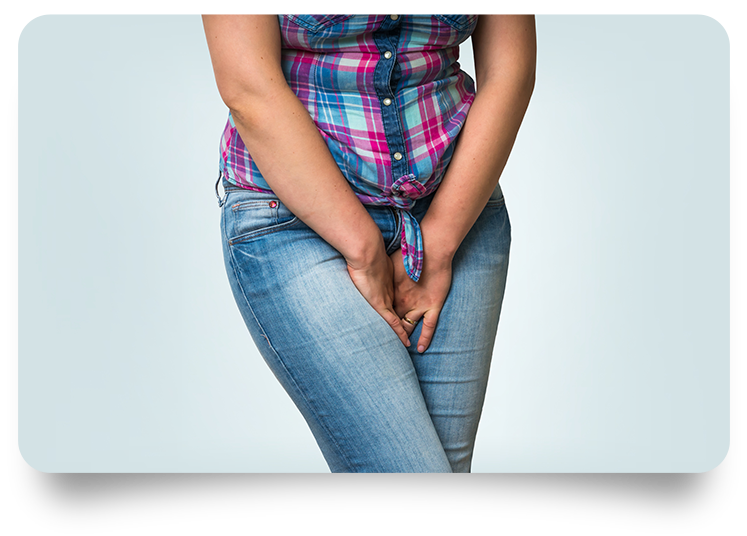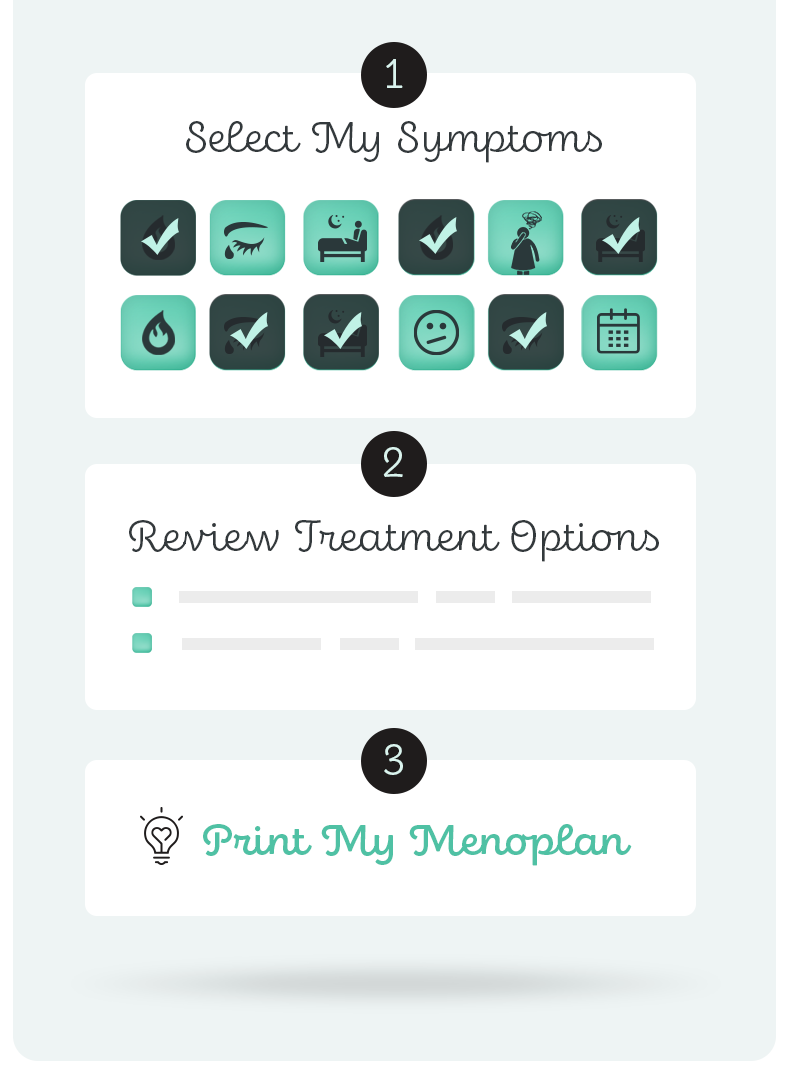Treatments
Coping with bladder control problems /urinary incontinence
- Talk to a doctor
- Keep a leak diary
- Reduce irritating foods & drinks
- Pay attention to when & how much you drink liquids
- Kegels / pelvic floor muscle training
- Bladder retraining
- Reduce coughing
- Our bottom line: Does it help?
- Helps for these symptoms
- May help for these symptoms
- Risks, side effects, & quality of life concerns
- If I want to try this, what are my next steps
- More of the science
- References
TALK TO YOUR DOCTOR
The first thing we suggest is talk with your doctor. Your doctor will try to find the underlying cause and to suggest possible treatments. They will also review your current drugs to see if they may be making things worse. They may suggest:
- Stopping use of a current medicine. Some drugs, such as sleep aids, diuretics, and antidepressants, may cause leakage by interfering with the signals between your brain and your bladder.
- Antibiotics, if the cause is a urinary tract infection.
- A drug to control the incontinence, such as duloxetine or anticholinergics like solifenacin and oxybutynin.
KEEP A LEAK DIARY
It can be helpful to keep a diary for a few days to see patterns and to show your doctor. It will help your doctor find the cause of your incontinence and pinpoint the right treatments. You can record how often you leak, get up at night to urinate, or have urgency to urinate. You can also track foods that that might irritate your bladder, your fluid intake, and activities that made you leak. Try printing and using this diary.
REDUCE IRRITATING FOOD & DRINKS
Some things we eat and drink may irritate the bladder and may make urgency worse. Try quitting then for a week and then add them back one at a time. Or eliminate one for a week and see if it helps. Then try another one. Then another, one at a time. These potential irritants include:
- Coffee and tea – even if they don’t have caffeine.
- Alcohol
- Acidic fruits like oranges, grapefruits, lemons and limes, and fruit juices
- Spicy foods
- Tomato-based products
- Carbonated drinks
- Chocolate
- Artificial sweeteners
PAY ATTENTION TO WHEN AND HOW MUCH YOU DRINK LIQUIDS
- Drink fewer liquids in the hours before bed.
- Highly concentrated urine (darker color) can irritate the bladder. Concentrated urine after you wake in the morning is normal. At other times, it’s a sign you need to drink more fluids. (Some vitamin pills may routinely turn your urine a darker color the next time you pee.) If you don’t drink many fluids during the day and your urine seems very concentrated, try drinking more water. This will make your urine less concentrated and may decrease urgency.
KEGELS /PELVIC FLOOR MUSCLE TRAINING
Kegels, also called pelvic floor muscle training (PFMT) is an exercise done to improve pelvic floor muscle strength, power, and endurance. Research shows that pelvic floor muscle training helps women who have either stress or urge urinary incontinence. In 1936 Dr. Arnold Kegel introduced PFMT into modern medicine. However, its roots are in ancient Chinese medicine. To build up your strength, you need to do them frequently and correctly.
How to do Kegels. The first step is to find the right muscles. Learn which muscles they are by stopping your pee mid-stream. Then try to replicate contracting those same muscles when you are not peeing. (It’s important to not keep contracting the muscles while peeing, which can lead to more urination problems.) It should feel like you are squeezing and lifting your pelvic floor.
If you are doing them correctly, no one should be able to tell that you are doing them. You can check yourself by sitting in front of a mirror. If your body moves up and down, then you are incorrectly using your thigh or buttocks instead of the pelvic floor muscles. You should not feel your stomach move if your put your hand on it. Keep breathing normally.
If you have any concerns about whether you are doing them correctly, talk to your OB/GYN, urologist, or a physical therapist specializing in pelvic floor muscle training.
How often to do Kegels. Some exercises schedules build strength, while others build endurance. The difference is in how many repetitions you do, how long you hold the muscles tight, and whether you build strength by increasing the effort for each contraction.
The American Urological Association recommends doing 30 Kegels, 2 times a day. Mix it up – do 10 lying down, 10 sitting, and 10 standing. Try holding each contraction for 3 seconds, and then resting for 3 seconds. Over time, you can try to hold the contractions for 10 seconds.
Behavioral training is when you practice Kegel contractions at the specific times that you are prone to leak, such as when coughing, lifting something heavy, or when you have strong urge to pee. Combined Kegels with bladder retraining (see below) to deal with urge incontinence.
Make kegels a habit. Tie them to something else in your day to make them a habit. Do them while brushing your teeth, pumping gas, stirring food on the stove, standing on a checkout line. No one knows you are doing them. See what happens when you do contractions during penetrative sex, too.
How well they work. You may need to try them for up to 3 months to feel a difference.
After women do pelvic floor muscle training for 6 weeks or longer, research show an average of 1 fewer leaks per day. For women with stress incontinence, 56% of them were cured by doing pelvic floor muscle training. The cure rate is slightly lower among women with urge incontinence – 35% – but about twice that reported some improvement. The exercises may improve control, enabling women to reach the toilet in time when the urge strikes. Women who did PFMT reported improved quality of life, better sex lives, and were less likely to seek further treatment than women in the control group.
BLADDER RETRAINING
The goal is to train the bladder to go longer between trips to the toilet by increasing the amount of urine your bladder can hold. The time periods should be increased slowly by 15 to 30 minutes, until you can go 3 to 4 hours without voiding. Use relaxation techniques (like paced respiration or deep breathing) and Kegels to put off urinating. If the urge is strong, but the time is not right, try to put if off for at least 5 minutes. If you work with a therapist or doctor, they will help establish a schedule for voiding during waking hours. It may take between 6 to 12 weeks to reach your retraining goal.
Combining bladder training with kegels (pelvic floor muscle training) seems to work better than either alone. Together, they help prevent leaks and lessen the sense of urgency.
REDUCE COUGHING
- Reduce coughs that trigger urinary leaks by soothing your throat, quitting smoking, or treating chronic obstructive pulmonary disease.
OUR BOTTOM LINE: DOES IT HELP?
YES. The techniques here will likely help most cases of urinary incontinence, but it ultimately depends on the cause of the incontinence.
Kegels can be done by everyone, since strong pelvic floor muscles helps to prevent future bladder control problems. For many women, doing pelvic floor exercises cures their incontinence, especially if they have stress incontinence. Most women show some improvement – such as fewer leaks per day and improved quality of life – even if they are not cured. Research shows that kegels and bladder retraining work better together to cure or improve urinary incontinence. If urge incontinence wakes you up at night, bladder retraining and kegels may help sleep through, too.
NO. If the cause of your incontinence is a urinary tract infection, you need to be treated by a doctor.

BLADDER CONTROL PROBLEMS

SLEEP PROBLEMS & INSOMNIA
Solutions for urge incontinence, such as kegels and bladder training, may help with waking during the night.
POTENTIAL RISKS & SIDE EFFECTS
None
QUALITY OF LIFE EXPECTATIONS
Increasing bladder control should increase your quality of life.
IF I WANT TO TRY THIS TREATMENT WHAT ARE MY NEXT STEPS?
- Keep a diary to look for patterns in when and why you leak. Times of day? Particular foods or liquids that trigger it? Drinking too close to bedtime?
- If you see a pattern you can change, try it.
- Meanwhile, do daily kegels. If you don’t know whether you are doing them correctly, see a physical therapist who specializes in the pelvic floor.
- Try bladder retraining, to hold your urine longer.
- Talk to your doctor if you still have a problem, or if you think one of your medicines may be triggering it. (If you suspect one of your meds, be sure to talk to your doctor BEFORE discontinuing or decreasing it.)
Alperin, M., Burnett, L., Lukacz, E., & Brubaker. 2019. The mysteries of menopause and urogynecologic health: Clinical and scientific gaps. Menopause, 26(1): 103-111. doi:10.1097/GME.0000000000001209.
Bjurlin et al. Carcinogen Biomarkers in the Urine of Electronic Cigarette Users and Implications for the Development of Bladder Cancer: A Systematic Review. European Urology Oncology. Published online: March 16, 2020. https://doi.org/10.1016/j.euo.2020.02.004
Cody JD, Jacobs ML, Richardson K, Moehrer B, Hextall A. Oestrogen therapy for urinary incontinence in post-menopausal women. Cochrane Database Syst Rev. 2012 Oct 17;10(10):CD001405. doi: 10.1002/14651858.CD001405.pub3. PMID: 23076892; PMCID: PMC7086391.
Dumoulin C, Cacciari LP, Hay Smith EJC. Pelvic floor muscle training versus no treatment, or inactive control treatments, for urinary incontinence in women. Cochrane Database of Systematic Reviews 2018, Issue10. Art.No.: CD005654. DOI: 10.1002/14651858.CD005654.pub4.
Fu, Y., Nelson, EA, & McGowan, L. 2019. Multifaceted self-management interventions for older women with urinary incontinence: A systematic review and narrative synthesis. BMJ Open 2019;9:e028626. doi:10.1136/bmjopen-2018-028626
Keating KN, Perfetto EM, Subedi P. Economic burden of uncomplicated urinary tract infections: direct, indirect and intangible costs. Expert Rev Pharmacoecon Outcomes Res 2005;5:457–466. [PubMed: 19807263]
Kinchen KS, Lee J, Fireman B, Hunkeler E, Nehemiah JL, Curtice TG. The prevalence, burden, and treatment of urinary incontinence among women in a managed care plan. J Womens Health (Larchmt). 2007;16:415-22. [PMID: 17439386]
Losada, (2016). Expert Panel Recommendations on Lower Urinary Tract Health of Women Across Their Life Span: Report from the Society for Women’s Health Research. JOURNAL OF WOMEN’S HEALTH Volume 25, Number 11. DOI: 10.1089/jwh.2016.5895.
Authors: Dr. Katherine Newton, & Dr. Leslie Snyder. Last reviewed February 15, 2021



